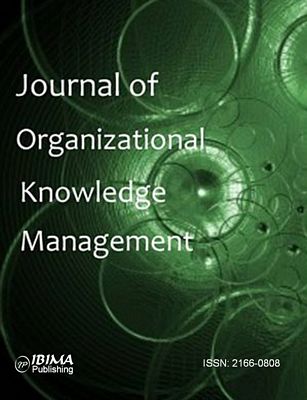Introduction
Modern organisations have to permanently evaluate their performance, global coherence and measure their information system efficiency. Organisations lean on audit and advisory companies, as well as on experts in information systems and information technology integration. These companies work in a complex and dynamic socio-economic environment, where visibility is an essential parameter for survival (Laudon and Laudon, 2011; Harris et al, 2008).
Generally, the problem these professionals encounter in Small and Medium-sized Enterprises (SMEs) is needs’ interpretation. This problem was identified in a pragmatic study realised within two firms of auditors and advisors, situated in the Rhône-Alpes region of France. In this study, we observe that the heterogeneity between formulated needs (customers’ companies) and their identification and interpretation (information technology professionals) generate situations of confusion.
Our interest concerns the analysis of documents provided by consulting in this context. We draw particular attention to the exploitation of a technological lexicon collected in this pragmatic study, in order to identify the semantic incoherences and ambiguities.
The aim of this study is to provide an ‘Assistance System of needs’ interpretation. The implementation on the ground of this system enables the identification of the research perspectives.
Literature Review
The socio-economic organisations environment is more and more complex, unpredictable and in perpetual transformation. In this unstable and uncertain context, organisations turn to the implementation of information intelligence and knowledge management processes. The focus will be on these processes in the context of audit and advisory companies in information technologies.
Information Intelligence in Organisations
We found in the litterature a variation of definitions of the information intelligence process in organisations (Bellon, 2002; Crowne, 2009). Information intelligence is considered to be the capacity to resolve problems, as a result of strategic knowledge, oriented to the action and the decision. This process requires the presence of relevant and necessary information, to know how to exploit it for problem resolution (Hauch et al, 2005; Poirier, 2000). This approach of production and appropriation of information content allows the optimisation of management processes. The process of information intelligence leans on several complementary competences (Boisvert, 2010).
The first level is the collection and structuring of the information necessary for the resolution of the problems that the organisations encounter.
The second level consists of analysing the collected information and identifying the strategies of exploitation and information-seeking.
The third level is the management and treatment of information, aimed at creating profitable and exploitable knowledge.
Finally, information intelligence leans on the communication and collaboration between the mobilised actors, in respect of ethical guidelines.
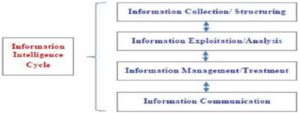
Fig 1. Necessary Competence for the Information Intelligence Process
More than ever, the human, organisational, intellectual and information capital exploitations create a superior value in organisations’ management. The knowledge generated by strategic and ‘intelligent’ information exploitation accentuates the performance of ‘modern’ organisations (Ermine, 2003).
Knowledge Management in Organisations
The information intelligence optimises the knowledge management by the implementation of devices and methods of knowledge valuation. There are many possible ways to describe and define knowledge management activities. In general, knowledge management is a process consisting of several steps that provide added value in organizations’ management practices. According to Å ikýř (2010), ‘the purpose of knowledge is to improve the storing, creation, sharing and use of knowledge in the organization, and thus improve performance of individual employees and the organization as a whole entity’. (Nanoka, 1994) consider that Knowledge Management is ‘context-specific’.
The organisation no longer has to limit itself to a role of information consumption; thus guaranteeing its survival and economic development. This concerns all organizations, whatever their size or business sector. Among the professional practices, we are interested in the technologic audit and advisory companies.
Information Intelligence and Knowledge Management in a Context of Audit and Advisory in Information System and Technologies
Firms of audit and advisory accompany organisations in the information systems and technology integration in their functional processes. They bring this help with the condition of assimilating and understanding the customers’ needs. It has to be admitted that, often, these conditions are far from being satisfied. The problems of needs’ understanding create the suggestion of inadequate solutions to the real needs of the SME.
Within SMEs, it is the ‘functional actors’, accompanied by technological professionals, who identify the needs. These needs must be the most explicit possible, otherwise the actors risk using incoherent and incomplete information.
Audit and advisory companies intervene in different communities, characterized by a specific language. These professionals have to become acquainted with the customers’ jargon. The implementation of information intelligence process in these firms allows them to create a context favourable to a common language use.
Research Context
We realize a study on the ground, which we refined between 2005 and 2011. This study concerns two audit and advisory firms, situated in the Rhône-Alpes region (France), that specialize in the integration of information technologies in SMEs. The problems of needs’ comprehension between customers’ organisation (needs formulation) and the audit and advisory companies (needs’ interpretation) are analysed.
This research work is based on a qualitative approach, leaning on ‘participant observation’ (DeWalt et al, 1998; Silverman, 2009), and enriched by constant exchanges with professionals of new technologies. The exploration on the ground allowed to analyse this research problem. The implementation of ‘focus groups’ consisted of consultants and customer organizations, and aimed to obtain information in order to clarify the problematic and identify the research hypothesis.
The present research focuses on an empirical study, based on the analysis of about fifty documents supplied by the studied consulting firms. The analysis is concerned with the technological vocabulary exploited in this pragmatic context. We extracted 100 ambiguous terms and expressions used by ‘non-specialist’ customers.
We observed that the use of the technological vocabulary was inconstant and the information detected was generally ambiguous. On the one hand, the actors who formulated the needs leaned on different referential terms (customers’ organization). Generally, they use the same concept to identify several expressions, characterised by various meanings, in a context of needs’ formulation. On the other hand, the audit and advisory companies encounter difficulties in term of needs’ interpretation. This situation generates problems of needs’ comprehension and exact identification.
The extracted technological vocabulary is the object of a linguistic analysis allowing us to determine the problems of semantic ambiguity. An ‘Assistance System of needs’ interpretation is proposed, based on the exploitation of a process of information intelligence and knowledge management. This system allows the establishment of a common language in a complex and dynamic activity. The research context is represented in the figure bellow.
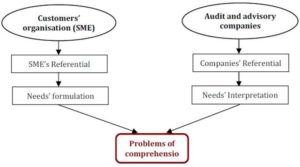
Fig 2. Research Context
Research Hypothesis and Questions
The information produced and exploited in the context of audit and advisory companies, and used for needs’ formulation, are complex and dynamic. This is the case owing to several criteria which structure this research hypothesis.
Hypothesis 1: The needs’ expression in organisations is carried out by the CIO (Chief Information Officer), if possible. Owing to financial difficulties, SMEs delegate the expression of needs to actors who are not necessarily experts in the technological field (such as, the financial officer, accountant etc.).
Hypothesis 2: In information system, projects involve generally heterogeneous actors (customers and technological actors). The variety and diversity of their referential produce phenomena of ‘complexity and semantic heterogeneousness’.
Hypothesis 3: Information technology field evolution creates a rapid transformation of the technological language. This evolution generates confusion in the use of the information technology terminology.
The study allowed analysing the semantic incoherence which exists between the formulation of needs and their interpretation. The constitution of a ‘common referential’ will help audit and advisory companies to face the problems of needs’ interpretation.
Research Design and Methodology
The process of information intelligence leans on complementary phases: collection, exploitation, management and communication of information. All these phases, declined in the present research context, result in the implementation of an Assistance System of needs’ interpretation. The system implementation ensures a social cohesion between heterogeneous actors (Boulesnane and Bouzidi, 2009).
Collection and Structuring of Information
We can sum up the first analysis phase by making a list of 100 terms used by ‘non-specialist’ customers. This corpus was extracted from 50 documents provided by the audit and advisory companies studied. The expressions and terms analysis reveals problems of incoherence and semantic ambiguity.
We cite some words and expression which constitute the lexicon: Database (DB); Database Management Systems; Datamining; Datawerhouse; Decision Support Systems; ERP (Enterprise Resource Planning); Expert System; Information and Communication Technologies (ICT); Informatics system; Information System (IS); Networks; Software; Web technologies etc.
Exploitation and Information-Seeking
In the second phase, a semantic analysis identified some relationships which we consider as ‘contextual relations’. Even if the approach is based on language analysis, we were interested more in the pragmatic level. Indeed, we observed that human actors are confused by the concepts, and tend, generally, to associate some terms with a second interpretation level, which we call ‘contextual synonymy’.
The treatment and filtering of this corpus allowed collecting a group of terms which are characterized by identical semantic relations. In order to organise and structure our corpus and the relationships between concepts, we use the graph theory. The objective is to give a synthetic overview of the different terms and the contextual relations which connect them. The exploitation of the graph leans on an approach offering two alternatives. The lexicon can be exploited by having either the lexicon (Lexical Database) or the profile of customers (Profile Database) as the point of departure.
By using different alternatives, we were able to exploit the terms extracted from the documents provided by the studied audit and advisory companies.
The proposed approach is consolidated by using tools and information management strategies.
Management and Treatment of Information
The various confusion cases are composed of a set of ‘terms candidates’, which constitute what we call an ‘interval of confusion’. This interval represents the subgraph, regrouping the various concepts able to be substituted with the confusion term. On the one hand, if the terms are in a direct commutation with this last one, the interval is qualified as an ‘immediate interval’. On the other hand, if the subgraph is composed of terms in an indirect commutation, the interval is ‘indirect’ (Boulesnane, 2008).
The immediate interval exploitation allows the consulting actors to start the information research and needs’ analysis. This first level contains the contextual relations commuted immediately with the term considered. The transition to the indirect interval is only possible if the user wants to refine the research (users’ questions).
Communication of Information
Furthermore, the use of the knowledge-based system herein proposed depends on the tools of information representation and exploitation, but the human expert represents the ultimate decision-maker who can orient the analysis of information.
The system is based on a heuristics method, which considers the potential ways to be followed in the situation of a problem resolution. The fundamental object is not to guarantee the most efficacious way, but to assist the user by proposing the potential case of confusion, which they can follow to resolve the problem. The consulting actors have several options and can contract these ways progressively, to refine the customers’ needs (Boulesnane and Bouzidi, 2009). The choice of a relevant and adequate interpretation allows the actors using the system to validate the customers’ needs (choice of interpretation).
The global system functioning is summarized in Figure 3.
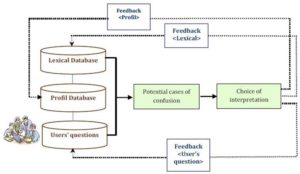
Fig 3. Global System Functioning
The case-based reasoning is pertinent in this research context (Bergmann et al, 2003). Indeed, a first phase of indexing allows the verification of whether the case which appears already exists in the system (lexical, profile and users’ question feedbacks).
Among the actors involved in our approach, this system can be very useful for junior consultants. The collaboration between the actors, who intervene in the process of information intelligence, is made in respect of business ethics which govern this professional practice.
The skills required for the implementation of the information intelligence is represented in the table below.
Table 1. Information Intelligence Process

Result and Discussion
To exploit the present approach, we lean on database management systems (relational databases). The exploitation of the system leans on the complementary phase (Figure 4).
The ‘Primary information analysis’ phase allows, from the documents’ analysis, to establish separately the information characterizing the profiles identification and the information representing the needs’ formulation
The ‘primary information structuring’ results in the constitution of a Lexical and Profile Database.
The phase of ‘Information exploitation’ allows the formalization of the process, represented by a succession of actions. In the treatment phase, the system’s users can access to every constituent of the system. They have in particular the possibility to exploit the Lexical and Profile databases (concepts, semantic relations and actor profiles). The access to the indexation of needs and profile is also possible.
Finally, the ‘information needs’ indexation’ is represented by the formalization of the hybrid approach. This phase allows indexing information needs and profile information, in order to supply the different databases.
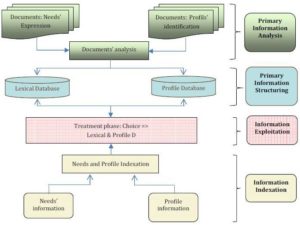
Fig 4. The Simulation of the Prototype
Research Limitation and Perspectives
The experimentation of the system was applied to an audit and advisory company, specialising in information technologies. About ten document sources, summarizing ambiguous needs, were exploited in this experiment.
Different elements allow a summary of the feedback, generated from the system experimentation. We cite, for example, the fact that the involvement of all the co-workers for this approach is important. The relevance of the used approach depends on the motivation of the users of system.
The various feedbacks allowed identifying some improvements. We list, for example, the extension of the technological lexicon, the improvement of the prototype, at both conceptual and technical levels, and the proposition of a practical guide allowing the clarification of our proposal. These various improvements constitute the research perspectives.
Conclusion
The approach proposed in this article makes a contribution to the resolution of the problems of needs’ interpretation. The basis of the process of information intelligence is built around an Assistance System of needs’ interpretation. This approach allows the recommendation of appropriate and pertinent technological solutions. The experiments of the system allowed identifying the research perspective.
References
Bellon, B. (2002). “Quelques Fondements de l’intelligence Economique,” Revue d’économie industrielle, Vol 98, n° 98. pp. 55-74.
Publisher – Google Scholar – British Library Direct
Bergmann, R., Althoff, K.- D., Breen, S., Göker, M., Manago, M. Traphoner, R. & Wess, S. (2003). “Developing Industrial Case-Based Reasoning Applications,” Germany: Springer. 236 p. ISBN: 3-540-20733-6.
Publisher – Google Scholar – British Library Direct
Boisvert, D. (2010). Le Développement de L’intelligence Informationnelle: Les Acteurs, les Défis et la Quête de Sens,Editions ASTED.
Publisher – Google Scholar
Boulesnane, S. (2008). ‘Proposition d’une Approche de Médiation pour l’aide à l’interprétation des Besoins Informationnels: Contexte d’audit et de Conseil en Systèmes d’Information et en Technologies de l’Information et de la Communication,’ Thèse de Doctorat, Université Jean Moulin-Lyon 3.
Google Scholar
Boulesnane, S. & Bouzidi, L. (2009). ‘Système d’aide à l’interprétation des Besoins: Vers une Approche Hybride,’ Revue Les Cahiers du Numérique. N° spécial en Intelligence Economique. v.5, n°4, p.138-164. Edition : Lavoisier.
Google Scholar
Crowne, K. A. (2009). “The Relationships among Social Intelligence, Emotional Intelligence and Cultural Intelligence,”Organization Management Journal; Fall2009, Vol. 6 Issue 3, p148-163, 16p.
Publisher – Google Scholar
DeWalt, K. M., DeWalt, B. R. & Wayland, C. B. (1998). ‘Participant Observation,’ In H.R. Bernard (Ed.), Handbook of methods in cultural anthropology. Pp: 259-299. Walnut Creek, CA: AltaMira Press.
Ermine, J.- L. (2003). “La Gestion des Connaissances,” 166p. Edition: Lavoisier.
Publisher – Google Scholar
Harris, M. D. S., Herron, D. & Iwanicki, S. (2008). The Business Value of IT: Managing Risks, Optimizing Performance, and Measuring Result, Édition: Boca Raton, FL: CRC Press, ISBN : 978-1-4200-6474-2 ; 1420064746.
Publisher – Google Scholar
Hauch, R., Miller, A. & Cardwell, R. (2005). “Information Intelligence: Metadata for Information Discovery, Access, and Integration,” SIGMOD ’05 Proceedings of the 2005 ACM SIGMOD international conference on Management of data. ACMNew York, NY, USA. ISBN: 1-59593-060-4 doi>10.1145/1066157.1066250.
Publisher – Google Scholar
Laudon, K. C. & Laudon, J. P. (2011). “Management Information Systems,” MyMISLab Series. Edition 12, illustrée. Prentice Hall PTR, 2011. ISBN 0132142856, 9780132142854. 557p.
Publisher – Google Scholar
Nanoka, I. (1994). “A Dynamic Theory of Organizational Knowledge Creation,” Organization Science, 5(1), 14—37.
Publisher – Google Scholar – British Library Direct
Poirier, D. (2000). ‘L’intelligence Informationnelle du Chercheur: Compétences Requises à l’ère du Virtuel,’ Québec:Bibliothèque de l’Université Laval. [Online], [January 19, 2012], Available:
http://www.4.bibl.ulaval.ca/poirier/intelligence_informationnelle/definition.htm>.
Google Scholar
Sabrina, B. & Laid, B. (2009). “Formulation des Besoins Informationnels dans une Activité Complexe et Dynamique: L’audit et le Conseil en Système d’Information et Nouvelles Technologies,” of the IBIMA (CIBIMA) journal of the International Business Information Management Association. V.10, n°10. p. 72-84Communications [Online], [Retrieved Mai 03, 2010], http://www.ibimapublishing.com/journals/CIBIMA/volume10/v10n10.pdf
Publisher
Å ikýř, M. (2010). ‘Human Resource Management Best Practices in Managing Knowledge Workers,’ In Theory management 2., 79 — 84, Žilina.
Google Scholar
Silverman, D. (2009). Doing Qualitative Research, London: Sage Publications. 456 p.
Publisher – Google Scholar



